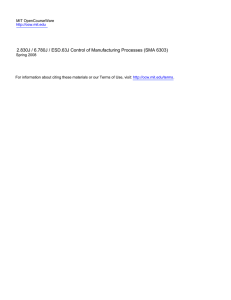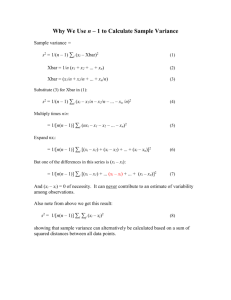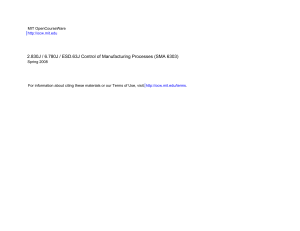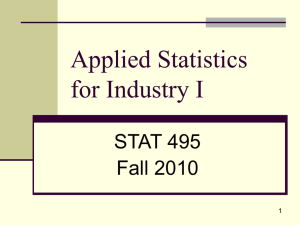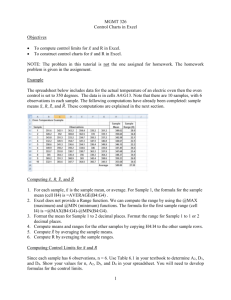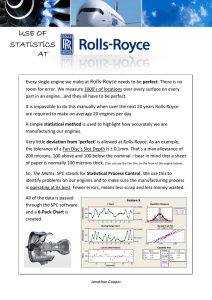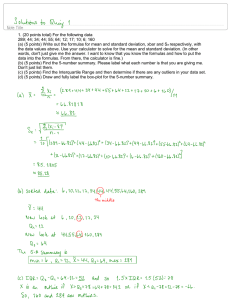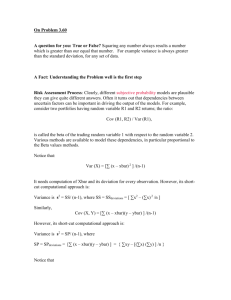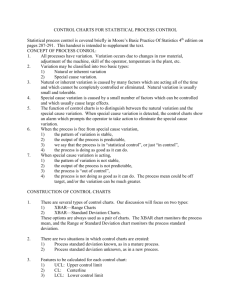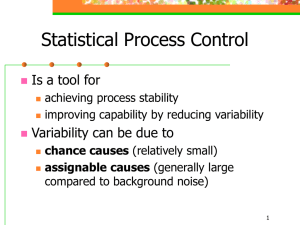____________ ________________ 2.830J / 6.780J / ESD.63J Control of Manufacturing Processes (SMA... MIT OpenCourseWare
advertisement
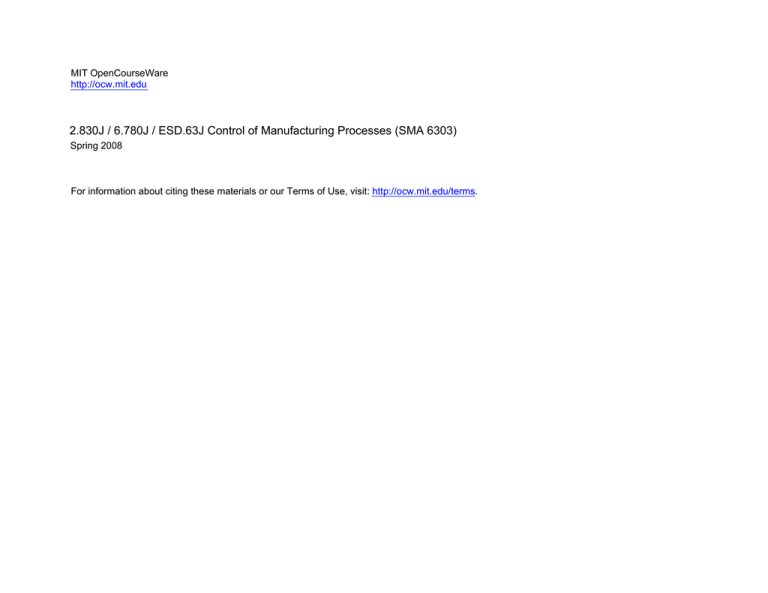
MIT OpenCourseWare
http://ocw.mit.edu
____________
2.830J / 6.780J / ESD.63J Control of Manufacturing Processes (SMA 6303)
Spring 2008
For information about citing these materials or our Terms of Use, visit: ________________
http://ocw.mit.edu/terms.
Control of
Manufacturing Processes
Subject 2.830/6.780/ESD.63
Spring 2008
Lecture #7
Shewhart SPC & Process Capability
February 28, 2008
Manufacturing
1
Applying Statistics to Manufacturing:
The Shewhart Approach
Text removed due to copyright restrictions. Please see the Abstract
of Shewhart, W. A. “The Applications of Statistics as an Aid in
Maintaining Quality of a Manufactured Product.” Journal of the
American Statistical Association 20 (December 1925): 546-548.
Manufacturing
2
Applying Statistics to Manufacturing:
The Shewhart Approach
Text removed due to copyright restrictions. Please see the Abstract
of Shewhart, W. A. “The Applications of Statistics as an Aid in
Maintaining Quality of a Manufactured Product.” Journal of the
American Statistical Association 20 (December 1925): 546-548.
Manufacturing
3
Applying Statistics to Manufacturing:
The Shewhart Approach (circa 1925)*
• All Physical Processes Have a Degree of Natural
Randomness
• A Manufacturing Process is a Random Process if all
“Assignable Causes” (identifiable disturbances) are
eliminated
• A Process is “In Statistical Control” if only “Common
Causes” (Purely Random Effects) are present.
Manufacturing
4
“In-Control”
...
i+2
m
i
T
e
i+1
Each Sample is
from Same Parent
i
Manufacturing
5
“Not In-Control”
...
i+2
m
i
T
e
i+1
i
Manufacturing
The Parent
Distribution is Not
The Same at
Each Sample
6
“Not In-Control”
...
Bi-Modal
Mean Shift + Variance Change
m
i
T
e
Mean Shift
What will appear in “Samples”?
Manufacturing
7
Xbar and S Charts
• Shewhart:
– Plot sequential average of process
• Xbar chart
• Distribution?
– Plot sequential sample standard deviation
• S chart
• Distribution?
Manufacturing
8
Data Sampling and Sequential Averages
• Given a sequence of process outputs xi:
j
j+1
j+2
...
sample interval ΔT
• A sequential sample of size n
n measurements
at sample j
Manufacturing
• Take at intervals ΔT
• Sample index j
9
Data Sampling
j
j+1
j+2
...
sample interval ΔT
jΔT + n
n measurements
1
xj =
xi
at sample j
n i = ( j− 1) ΔT +1
∑
sample j mean
jΔT +n
Sj
Manufacturing
2
1
2
=
(x i − x j ) sample j variance
∑
n − 1 i = ( j −1)ΔT
10
Subgroups
j
j+1
j+2
...
• Within Subgroup Statistics
n measurements
at sample j
– xbar j , Sj
• Between Subgroup Statistics
– Average of xbarj
– Variance of xbar(j)
Manufacturing
11
Plot of xbar and S
Random Data n=5
xbar
0.9
0.8
0.7
0.6
0.5
0.4
0.3
0.2
0.1
0
1
2
3
4
5
6
7
8
9
10
11
12
13
14
15
16
17
18
19
20
11
12
13
14
15
16
17
18
19
20
Sample Number
S
0.45
0.4
0.35
0.3
0.25
0.2
0.15
0.1
0.05
0
1
2
3
4
5
6
7
8
9
10
Run number
Manufacturing
12
Overall Statistics
0.9
0.8
0.7
0.6
0.5
0.4
1 N
x = ∑ xj
N i =1
0.3
0.2
0.1
0
1
2
3
4
5
6
7
Grand Mean
8
9
10
11
12
13
14
15
16
17
18
19
20
18
19
20
Sample Number
0.45
0.4
0.35
0.3
0.25
1 N
S = ∑ Sj
N i =1
0.2
0.15
0.1
0.05
Grand Standard Deviation
0
1
2
3
4
5
6
7
8
9
10
11
12
13
14
15
16
17
Run number
Manufacturing
13
Setting Chart Limits
• Expected Ranges
– Grand mean and Variance
• (based on what data and how many data points?)
• Confidence Intervals
– Intervals of + n Standard Deviations
– Most Typical is + 3σ (US) or 0.1% (Europe)
Manufacturing
14
Chart Limits - Xbar
• If we knew σx then:
1
σx =
σx
n
• But Since we Estimate the Sample Standard
Deviation, then
E(S j ) = C4 σ x
where
Manufacturing
(Sj is a biased estimator)
⎛ 2 ⎞
C4 = ⎝
n − 1⎠
1/ 2
Γ(n / 2)
Γ((n − 1) / 2)
15
Chart Limits xbar chart
With this “correction” we can set limit at ±3σxbar
Or set a confidence interval of 99.7%
Or a test significance of 0.3%
UCL = x + 3
S
C4 n
For the example n=5
Manufacturing
LCL = x − 3
C4 = (0.5)
1/ 2
S
C4 n
Γ(2.5)
1.33
= 0.707
= 0.94
Γ(2)
1
16
Chart Limits S
The variance of the estimate of S can be shown
to be:
2
σ S = σ 1 − C4
So we get the chart limits:
S
2
UCL = S + 3
1 − C4
C4
S
2
LCL = S − 3
1 − C4
C4
Manufacturing
17
Example xbar
1
0.9
UCL
0.8
0.7
0.6
Grand
0.5
0.4
Mean
0.3
0.2
LCL
0.1
0
1
2
3
4
5
6
7
8
9
10
11
12
13
14
15
16
17
18
19
20
sample number
Manufacturing
18
Example S
0.7
0.6
UCL
0.5
0.4
Grand S
0.3
0.2
0.1
LCL
0
1
2
3
Manufacturing
4
5
6
7
8
9
10
11
12
13
14
15
16
17
18
19
20
19
Detecting Problems
from Running Data
• Appearance of data
– Confidence Intervals
– Frequency of extremes
– Trends
Manufacturing
20
The 8 rules from Devor et al
(Based on Confidence Intervals)
•
•
•
•
Prob. of data in a band
Based on Periodicity
Based on Linear Trends
Based on Mean Shift
Manufacturing
21
Test for “Out of Control”
• Extreme Points
– Outside ±3σ
• Improbable Points
– 2 of 3 >±2σ
– 4 of 5 >± 1σ
– All points inside ±1σ
Manufacturing
22
Tests for “Out of Control”
• Consistently above or below centerline
– Runs of 8 or more
• Linear Trends
– 6 or more points in consistent direction
• Bi-Modal Data
– 8 successive points outside ±1σ
Manufacturing
23
Applying Shewhart Charting
•
•
•
•
Find a run of 25-50 points that are “in-control”
Compute chart centerlines and limits
Begin Plotting subsequent xbarj and Sj
Apply the 8 rules, or look for trends, improbable
events or extremes.
• If these occur, process is “out of control”
Manufacturing
24
Out of Control
• Data is not Stationary
(μ or σ are not constant)
• Process Output is being “caused” by a disturbance
(common cause)
• This disturbance can be identified and eliminated
– Trends indicate certain types
– Correlation with know events
• shift changes
• material changes
Manufacturing
25
Western Electric Rules
(See Table 4-1)
•
•
•
•
Points outside limits
2-3 consecutive points outside 2 sigma
Four of five consecutive points beyond 1 sigma
Run of 8 consecutive points on one side of
center
Manufacturing
26
“In-Control”
...
i+2
T
e
m
i
i+1
What will chart
look like?
i
Manufacturing
27
“Not In-Control”
...
i+2
T
e
m
i
i+1
What will chart
look like?
i
Manufacturing
28
Detecting Mean Shifts:
Chart Sensitivity
• Consider a real shift of Δμx:
1
0.9
0.8
0.7
0.6
0.5
0.4
0.3
0.2
0.1
0
1
2
3
4
5
6
7
8
9
10
11
12
13
14
15
16
17
18
19
20
Sample Number
• How many samples before we can expect to
detect the shift on the xbar chart?
Manufacturing
29
Average Run Length
• How often will the data exceed the ±3σ limits
if Δμx = 0?
Prob(x > μ x + 3σ x ) + Pr ob(x < μ x − 3σ x )
= 3 / 1000
0.45
0.4
0.35
0.3
0.25
0.2
0.15
0.1
0.05
-4
Manufacturing
-3
−3σ
0
-2
-1
μ0
1
2
3
+3σ
4
30
Average Run Length
• How often will the data exceed the ±3σ limits
if Δμx = +1σ?
Prob(x > μ x + 2σ x ) + Prob(x < μ x − 4σ x )
= 0.023 + 0.001 = 24 / 1000
0.45
0.45
Actual
0.4
0.4
0.35
0.35
Assumed
Distribution
0.3
0.3
Distribution
0.25
0.25
-4
Manufacturing
−3σ
-4
-3
0.2
0.2
0.15
0.15
0.1
Δμ
0.1
0.05
0.05
0
-3
-2
-2
-1
μ
-1
0
pe
0
01
12
23
+3σ
34
4
31
Definition
• Average Run Length (arl): Number of runs (or
samples) before we can expect a limit to be
exceeded = 1/pe
– for Δμ = 0
– for Δμ = 1σ
arl = 3/1000 = 333 samples
arl = 24/1000 = 42 samples
Even with a mean shift as large as 1σ, it
could take 42 samples before we know it!!!
Manufacturing
32
Effect of Sample Size n on ARL
• Assume the same Δμ = 1σ
– Note that Δμ is an absolute value
• If we increase n, the Variance of xbar
σx
decreases:
σx =
n
• So our ± 3σ limits move closer together
Manufacturing
33
ARL Example
Original
Distribution
-4
−3σ
-3
0.450.45
0.45
0.40.4
0.4
0.350.35
0.35
0.30.3
0.3
0.250.25
0.25
0.20.2
0.2
0.150.15
0.15
0.10.1
Δμ 0.1
0.050.05
0.05
00
-2
-4
new limits
-3
-1
-4
-2
−3σ∗
-3
-1
μ
0-2
New
Distribution
pe
0
1-1
1
20
31
+3σ∗
422
3
34
+3σ
4
same absolute shift
As n increases pe increases so ARL decreases
Manufacturing
34
Design of the Chart
• Sample size n
– Central Limit theorem
– ARL effects?
• Selection of Reference Data
– Is S at a minimum ?
•
Sample time ΔT
– Cost of sampling
– production without data
– Rapid phenomena
j
...
Sample size and “filtering”
versus response time to
changes
j+1j+2
sample interval ΔT
Manufacturing
35
Limits and Extensions
•
•
•
•
Need for averaging
Assumptions of Normality
Assumption of independence
Pitfalls
– Misinterpretation of Data
– Improper Sampling
• What are alternatives?
– Different Sampling Schemes
– Different Averaging Schemes
– Continuous Update to Improve Statistics
Manufacturing
36
Conclusions
• Hypothesis Testing
– Use knowledge of PDFs to evaluate hypotheses
– Quantify the degree of certainty (a and b)
– Evaluate effect of sampling and sample size
• Shewhart Charts
– Application of Statistics to Production
– Plot Evolution of Sample Statistics x and S
– Look for Deviations from Model
Manufacturing
37
Detection : The SPC Hypothesis
0.9
0.8
0.7
Process
0.6
Y
0.5
0.4
0.3
0.2
0.1
0
1
2
3
4
5
6
7
8
9
10
11
12
13
14
15
Sample Number
16
17
18
19
20
In-Control
...
...
p(y)
Not
In-Control
Manufacturing
38
Out of Control
• Data is not Stationary
(μ or σ are not constant)
• Process Output is being “caused” by a
disturbance (assignable or special cause)
• This disturbance can be identified and
eliminated
– Trends indicate certain types
– Correlation with know events
• shift changes
• material changes
Manufacturing
39
Use of the S Chart
• Plot of sample Variance
– Variance of the Mean for Shewhart xbar (n>1)
• What Does it Tell Us about State of Control?
– It simply plots the “other” statistic
Manufacturing
40
Consider this Process
Xbar Chart
1
0.9
UCL
0.8
0.7
0.6
0.5
0.4
0.3
0.2
LCL
0.1
0
1
2
3
4
5
6
7
8
9
10
11
12
13
14
15
16
17
18
19
20
sample number
Manufacturing
41
And the S Chart
0.6
UCL
0.5
0.4
0.3
0.2
0.1
LCL
0
1
2
Manufacturing
3
4
5
6
7
8
9
10
11
12
13
14
15
16
17
18
19
20
42
In Control?
Manufacturing
43
Same Process Later in Time
Xbar
1
0.9
UCL
0.8
0.7
0.6
0.5
0.4
0.3
0.2
LCL
0.1
0
1
2
3
4
5
6
7
8
9
10
11
12
13
14
15
16
17
18
19
20
sample number
Manufacturing
44
Later S Chart
0.6
UCL
0.5
0.4
0.3
0.2
0.1
LCL
0
1
2
Manufacturing
3
4
5
6
7
8
9
10
11
12
13
14
15
16
17
18
19
20
45
What Changed??
Manufacturing
46
A Different Sequence
Xbar
1
0.9
UCL
0.8
0.7
0.6
0.5
0.4
0.3
0.2
LCL
0.1
0
1
2
3
4
5
6
7
8
9
10
11
12
13
14
15
16
17
18
19
20
sample number
Manufacturing
47
S Chart
0.6
UCL
0.5
0.4
0.3
0.2
0.1
LCL
0
1
2
Manufacturing
3
4
5
6
7
8
9
10
11
12
13
14
15
16
17
18
19
20
48
Use of S Chart
• Detect Changes in Variance of Parent
Distribution
• Distinguish Between Mean and Variance
Changes
Manufacturing
49
Statistical Process Control
• Model Process as a Normal Independent* Random
Variable
• Completely described by μ and σ
• Estimate using xbar and s
• Enforce Stationary Conditions
• Look for Deviations in Either Statistic
• If so ………..?
• Call an Engineer!
Manufacturing
50
Another Use of the
Statistical Process Model:
The Manufacturing -Design Interface
• We now have an empirical model of the
process
0.45
0.4
0.35
0.3
How “good” is the
process?
0.25
0.2
0.15
0.1
0.05
Is it capable of
producing what we
need?
Manufacturing
0
-4
-3
−3σ
-2
-1
0
μ
1
2
3
4
+3σ
51
Process Capability
• Assume Process is In-control
• Described fully by xbar and s
• Compare to Design Specifications
– Tolerances
– Quality Loss
Manufacturing
52
Design Specifications
• Tolerances: Upper and Lower Limits
Characteristic
Dimension
Target
Lower
x*
Specification
Limit
Upper
Specification
Limit
LSL
USL
Manufacturing
53
Design Specifications
• Quality Loss: Penalty for Any Deviation from
Target
QLF = L*(x-x*)2
How to
Calibrate?
x*=target
Manufacturing
54
Use of Tolerances:
Process Capability
• Define Process using a Normal Distribution
• Superimpose x*, LSL and USL
• Evaluate Expected Performance
0.45
0.4
0.35
0.3
0.25
0.2
0.15
0.1
0.05
LSL
-4
Manufacturing
-3
−3σ
x* 0
-2
-1
μ0
USL
1
2
3
+3σ
4
55
Process Capability
• Definitions
(USL − LSL)
tolerance range
Cp =
=
6σ
99.97% confidence range
• Compares ranges only
• No effect of a mean shift:
Manufacturing
56
Process Capability: Cpk
C pk
⎛ (USL − μ ) (LSL − μ) ⎞
= min⎝
,
⎠
3σ
3σ
= Minimum of the normalized
deviation from the mean
• Compares effect of offsets
Manufacturing
57
Cp = 1; Cpk = 1
0.45
0.4
0.35
0.3
0.25
0.2
0.15
0.1
0.05
0
-4
Manufacturing
-3
-2
-1
0
1
2
3
4
58
Cp = 1; Cpk = 0
0.45
0.4
0.35
0.3
0.25
0.2
0.15
0.1
0.05
0
-4
-3
-2
Manufacturing
-1
0
1
2
3
4
59
Cp = 2; Cpk = 1
0.45
0.4
0.35
0.3
0.25
0.2
0.15
0.1
0.05
0
-4
Manufacturing
-3
-2
-1
0
1
2
3
4
60
Cp = 2; Cpk = 2
0.45
0.4
0.35
0.3
0.25
0.2
0.15
0.1
0.05
0
-4
Manufacturing
-3
-2
-1
0
1
2
3
4
61
Effect of Changes
• In Design Specs
• In Process Mean
• In Process Variance
• What are good values of Cp and Cpk?
Manufacturing
62
Cpk Table
Manufacturing
Cpk
z
P<LS or
P>USL
1
3
1E-03
1.33
5
3E-07
1.67
4
3E-05
2
6
1E-09
63
The “6 Sigma” problem
P(x > 6σ) = 18.8x10-10
Cp=2
0.45
Cpk=2
0.4
0.35
0.3
0.25
0.2
0.15
0.1
0.05
-4
LSL
−3σ∗
-3
-2
0
-1
0
1
+3σ∗
2
3
4
USL
6σ
Manufacturing
64
The 6 σ problem: Mean Shifts
P(x>4σ) =
Cp=2
31.6x10-6
0.45
Cpk=4/3
0.4
Even with a mean shift of 2σ
we have only 32 ppm out of spec
0.35
0.3
0.25
0.2
0.15
0.1
0.05
0
-4
-3
-2
-1
0
1
2
LSL
3
4
USL
4σ
Manufacturing
65
Capability from the Quality Loss Function
QLF = L(x) =k*(x-x*)2
x*
Given L(x) and p(x) what is E{L(x)}?
Manufacturing
66
Expected Quality Loss
E{L(x)} = E[k(x − x*)
2
]
= k [E(x ) − 2E(xx*) + E(x * )]
2
2
= kσ + k( μx − x*)
2
x
Penalizes
Variation
Manufacturing
2
Penalizes
Deviation
67
Process Capability
•
•
•
•
•
The reality (the process statistics)
The requirements (the design specs)
Cp - a measure of variance vs. tolerance
Cpk - a measure of variance from target
Expected Loss- An overall measure of
goodness
Manufacturing
68
